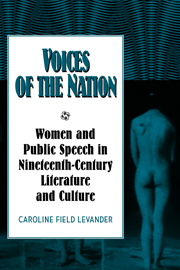Book contents
- Frontmatter
- Contents
- Acknowledgments
- Introduction: Gender, Speech, and Nineteenth-Century American Life
- 1 Bawdy Talk: The Politics of Women's Public Speech in Henry James's The Bostonians and Sarah J. Hale's The Lecturess
- 2 “Foul-Mouthed Women”: Disembodiment and Public Discourse in Herman Melville's Pierre and E. D. E. N. Southworth's The Fatal Marriage
- 3 Incarnate Words: Nativism, Nationalism, and the Female Body in Maria Monk's Awful Disclosures
- 4 Southern Oratory and the Slavery Debate in Caroline Lee Hentz's The Planter's Northern Bride and Harriet Jacobs's Incidents in the Life of a Slave Girl
- 5 Partners in Speech: Reforming Labor, Class, and the Working Woman's Body in Elizabeth Stuart Phelps's The Silent Partner
- 6 “Queer Trimmings”: Dressing, Cross-dressing, and Woman's Suffrage in Lillie Devereux Blake's Fettered for Life
- Conclusion: Women and Political Activism at the Turn into the Twentieth Century
- Notes
- Select Bibliography
- Index
- CAMBRIDGE STUDIES IN AMERICAN LITERATURE AND CULTURE
5 - Partners in Speech: Reforming Labor, Class, and the Working Woman's Body in Elizabeth Stuart Phelps's The Silent Partner
Published online by Cambridge University Press: 27 October 2009
- Frontmatter
- Contents
- Acknowledgments
- Introduction: Gender, Speech, and Nineteenth-Century American Life
- 1 Bawdy Talk: The Politics of Women's Public Speech in Henry James's The Bostonians and Sarah J. Hale's The Lecturess
- 2 “Foul-Mouthed Women”: Disembodiment and Public Discourse in Herman Melville's Pierre and E. D. E. N. Southworth's The Fatal Marriage
- 3 Incarnate Words: Nativism, Nationalism, and the Female Body in Maria Monk's Awful Disclosures
- 4 Southern Oratory and the Slavery Debate in Caroline Lee Hentz's The Planter's Northern Bride and Harriet Jacobs's Incidents in the Life of a Slave Girl
- 5 Partners in Speech: Reforming Labor, Class, and the Working Woman's Body in Elizabeth Stuart Phelps's The Silent Partner
- 6 “Queer Trimmings”: Dressing, Cross-dressing, and Woman's Suffrage in Lillie Devereux Blake's Fettered for Life
- Conclusion: Women and Political Activism at the Turn into the Twentieth Century
- Notes
- Select Bibliography
- Index
- CAMBRIDGE STUDIES IN AMERICAN LITERATURE AND CULTURE
Summary
After summarizing the work of “scholars who study the economic, the political, and the realistic novel,” Carol Farley-Kessler concludes that Elizabeth Stuart Phelps is “without exception” considered to be “the first American novelist to treat the theme of urban, industrial blight” in her 1871 novel, The Silent Partner. Yet literary critics who have recently begun to evaluate the novel's depictions of women labor reformers have argued that the novel is politically conservative, even “regressive.” Focusing exclusively on Perley Kelso's quest to develop her voice despite her status as a “silent” partner in the mill, these scholars have argued that, while the book does address the crucial question of how a bourgeois woman can productively use her voice to advocate for mill workers, Perley's public speech ends up reinforcing rather than contesting or subverting the middle-class gender codes that confine her. Pointing out that her public speech champions the mill owners' cause and thereby undermines the workers' will to strike, these analyses conclude that the novel finally “serve [s] the interests of the middle class, registering what is already changed at the sphere boundaries.” While Perley's voice and her public speech are indisputably the result of, and so reinforce, her class privilege, I want to expand existing conversations regarding the text's political significance by showing, first, that the political impact of the text does not depend exclusively on the success of a middle-class woman's attempts to exert herself in order to benefit “the hands” of her mill; second, that by focusing on the middle-class woman, rather than on the working women who abound in the text, in order to determine the novel's political contribution, scholars have inadvertently replicated the rhetorical strategies of the bourgeois women who controlled the women's labor reform movement in the 1870s and filtered its politics through a middle-class lens; and third, that by placing the novel within the historical context of the nineteenth-century labor reform movement and its women reformers' descriptions of wage-earning women, we can see how The Silent Partner challenges reformers' ideas about such women and their labor rhetoric.
- Type
- Chapter
- Information
- Voices of the NationWomen and Public Speech in Nineteenth-Century American Literature and Culture, pp. 98 - 116Publisher: Cambridge University PressPrint publication year: 1998



